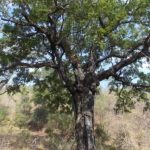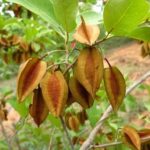Tree Life
August 1981
MASHONALAND CALENDAR
Saturday August 1st : 1030 hours. Botanic Garden Walk. Meet in the car park.
Sunday August 16th : Serui Source, Norton area, home of Mr.Ralph Palmer a member of many years standing. I found a reference to him attending the AGM on 22nd May 1960 and in the days when the Society was active in the McIlwaine Arboretum. Ralph helped considerably by bringing along his labour gang during the tobacco off season to assist with bush clearing. I do not believe we have visited that area before and in addition I am sure that we will receive a very warm welcome.
Although we have booked a bus whether we get one or not depends entirely on the availability of diesel. As optimists – booking slip attached, Fare $4.00. Please give your telephone number so that we can contact you if necessary. Please also indicate if you would be willing to take your own car and a number of passengers or whether you would rather go with someone else. Whatever mode of transport, we will meet at the Monomatapa Car Park to leave at 0900 hours, a Security Guard will be employed as usual.
Saturday August 22nd : Learner group by arrangement with Mrs. Gill Masterson – Tel. 30343,if you would like to be included. I would not miss it for anything. This is an opportunity to study a few trees in detail, and learn to recognise their characteristics.
Sunday August 30th : A visit to the Ayshire Branch. Meet at Mafuta Farm. 1000 hours.
Saturday and Sunday September 19th and 20th: Umtali. Leave Salisbury, Monomatapa Car Park at 0800. Tea in Rusape. De-bus at the Fairbridge Memorial on the top of Christmas Pass. From there we will be taken by smaller vehicles along the top of Cecil Kop to the spot where we will have lunch (Please bring your own picnic lunches).
John Burrows of the Wild Life Society and son of the Burrows from Spelenken, who will be our host in the Cecil Kop Nature Reserve writes “I have been doing a bit of planning regarding the best route to take you all and have actually just completed a new path which I think we will get you to christen, and name the trees on route. Since you probably do not get into much forest I have planned a route along the summit of Cecil Kop Range which includes some beautiful views together with some of our most interesting forest. The walk is circular, for the most part is levelish walking and will take about 2-3 hours of dawdling and discussing plants – and fauna. The route is rather rocky in places and I suggest you all wear good strong shoes, there is, however, no bundu bashing!”
It sounds most exciting. John has produced a check list of “Some Trees and Shrubs of the Cecil Kop Nature Reserve” which he told me he intends to update before our visit so I am sure it will not be necessary for us to do any naming of trees for him. When we get back to the bus I suggest go round to bottom of the Nature Reserve to the Game Viewing area before dispersing. For those staying at hotels the bus will take you there and collect you again the next morning. For those staying with friends; your friends could either meet you at the Fairbridge Memorial 12 noon to 1230 hours and join us for the afternoon, or meet you at the Game Viewing area from 1700 hours onward or at one of the hotels from about 1800 hour. As I feel we will have had a very full day Saturday evening will be “at leisure”. Sunday : Murahwa’s Hill. Mr. Apsley Pellatt, one of the Wardens for Murahwa’s Hill confesses that he knows little about trees, however he is knowledgeable about birds and is the Hon. Secretary of the Eastern Districts Bird Club and I hope that John Burrows will be able to join us again. I have a copy of the check list drawn up by the late Norman Chase who was responsible for the development of Murahwa’s Hill and who spent so much time cutting the paths through the forest which will so facilitate our visit to the Hill. We should congregate at the Showground area entrance to Murahwa’s Hill at 0930 hours and the bus will leave from there at 1400 hours after a picnic lunch once again provided by yourselves. Booking slip attached. Mrs Lola Irvine has kindly offered to take over the booking arrangements.
I very much hope that members from the eastern Districts will join us. I look forward to meeting you.
-Meg Coates Palgrave
BOTANIC GARDEN WALK, 4TH JULY
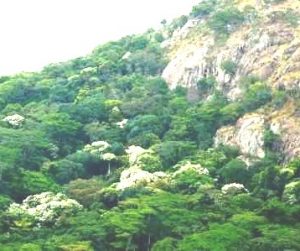
Crabia brevicaudata -Bunga View,Vumba. Photo: Bart Wursten. Source: Flora of Zimbabwe.
Alec Dry joined us for the Botanic Garden walk. He assured me that his presence was to raise the tone of the occasion so I asked him for some notes on the walk – to raise the tone of the Newsletter. Here is what he had to say : The stroll through the Botanical Gardens on 4th July was designed to be a prelude to our visit to Wedza and Meg Coates Palgrave introduced us to some of the typical trees to be seen there. So we met the elegant Crabia brevicaudata, the Olea capensis (missing from the Botanical Dictionary), juvenile samples of Rhus natalensis, the thorny liane Toddalia asiatica and a Rapanea melanophloeos.
These were all easily identified by our panel of experts, but others caused some consternation. The leaves of the Apodytes dimitiata proved to be variable to the point of schizophrenia. Others shared a sort of mid winter waywardness; the Homalium dentatum pretended to be a mulberry tree, Rhamnus prinoides looked like the common domestic plum; we were warned at a Myrica pilulifera had disguised itself as Pappea capensis but perhaps luckily for us we did not run into it.
The Ilex mitis caused some excitement when sharp eyes detected hair like teeth on the margins of the leaves. Similar to those characteristic of the Christmas holly of Maesa lanceolata; and in tiny pockets in the axils of the veins on the underside of the leaves of Linociera battiscombei one could see with the aid of a lens (and some imagination) tiny insects busy doing whatever tiny insects do in the pockets of axils of the veins on the underside of the leaves of Linociera battiscombei.!!
Thanks to Meg for her preparatory work and enthusiasm and for her contribution of yet another term to our botanical vocabulary “drip tip”.
And thank you Alex for that account. Unfortunately I cannot claim drip tip as original.
WEDZA MOUNTAIN 19TH JULY 1981
With the diesel crisis we all wondered if our bus would be cancelled and whether we would get to the Wedza Mountain after all. The bus was not cancelled and in addition we had a day of brilliant sunshine instead of the guti there could have been and I hope that the other 64 people who came enjoyed the day as much as I did. It was a special day visiting a special place. Because of that we made a number of unprecedented arrangements and I shall mention, and express my thanks to those who contributed to the success of the day as we go along and not leave it all to the end. My first thank you is to Mrs. Lola Irvine for all the work she does towards bus bookings. I believe that the fact that our bus was not cancelled was in no small way due to her public relations with the bus company. Making arrangements for 65 people to make and pay for a trip on a 36 seater bus requires the special patience and charm which Lola has. Thank you too to Douglas Irvine for going out by car and enabling us to accommodate in the hired vehicles all those who wanted to join the trip and also for later leading one of the parties. I have just mentioned hired vehicles, we had the bus and in addition we hired a Land rover because I was convinced that lovely and interesting as the vegetation is low down the mountain it would be very sad if members felt that they had missed something because they had not been able to breath the cool mountain air nor admire the view and it is quite a trek even to the saddle. In addition to the hired Land rover which Ken Davey drove up and down the difficult part we had the pleasure of the presence of Gerald Pope, his family and the Herbarium Landrover. Gerald, in between haring up and down the mountain with parties of people, added considerably to our instinctive guess work identification with his sound botanical reasoning Gerald, we hope you and your family enjoyed the day and will join us on future outings. You will be most welcome. The bus stopped rather short of the intended spot so we piled everything into the Land rover and took it to where we wanted it to be. Paul volunteered to look after the katundu when everyone else went up the mountain. This enabled all to get away quickly and not spend hours packing everything away.
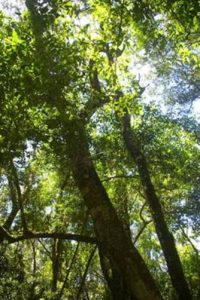
Olea capensis. Photo: Plantz Africa
Our destination “up” was the saddle between the [peaks of Romorehoto and Dangamvuri and a very rewarding one at that. Catha edulis, bushman’s tea recognisable by its opposite leaves with very serrated margins and looking like an isolated patch of small gum trees was our first landmark. The leaf shape and size of subsequent specimens was very variable and frequently had us wondering. Our next discussion centred round Schrebera alata, the wing leaved wooden pear, this was after we had admired the Sabi River stretching into the hazy distance. I understand that from here on a clear day one can see Mount Rudd, which is a landmark at Birchenough Bridge, as well as other mountainous features in the Eastern Districts. I have heard that the Wedza Mountains can be seen from near Eagles Nest (we must have a look on our way to Umtali). When we reached our gully our day was made for apart from Strychnos mitis and Oxyanthus speciosus we saw all we had come to see. Firstly, Olea capensis, the Ironwood Olive with its opposite leaves and very short purple petiole, then Mimusops zeyheri, very variable but distinctive with it milky juice, a member of the milkwood family. Being milky it bears a resemblance to the fig trees but it does not have the growing tip characteristic of that family, and I think has a narrower more finely textured leaf. I must learn to think Mimusops as I so frequently do not recognise it. A member of the same family Sapotaceae is, the stem fruit which was conspicuous by its absence in a place where one imagines it should be. If anyone did spot one I should be very interested to hear about it. Rapanea melanophloeos was recognised as the Cape Boekenhout instantly by our member from South Africa. Obviously those on Wedza Mountain are more like the South African ones than those we are accustomed to. Regeneration in that gully and its vicinity was most satisfactory and Homalium dentatum as a sapling was considered easier to identify than the tall trees with serrated leaves visible against the sky. I thought that this Common Homalium was a most exciting find as it is not illustrated in the book because we never found it to photograph. Crabia brevicaudata was another tree reaching into the sky which we learnt we could recognise by its compound leaf, the leaflets sub-opposite to alternate and a rachis which seems to change direction at each leaflet. We were not able to see this detail but the field impression of light green leaves with wavy margins became easily recognisable. I have a memory of white flowering trees splashing the Vumba mountains – those were Crabia brevicaudata, my recollection is that that was during October-November so I think we will be a little early visiting Umtali in September. Another species associated with Umtali which I expected to see and did not was Zanha golungensis which grows on Murahwa’a Hill as does the Cordia abyssinica and they occur together at Shamva – why not at Wedza? Perhaps it is too cool or too high?
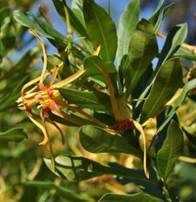
Strophanthus speciosus. Photo: Wikipedia
With its distribution in Zimbabwe confined to Wedza and Buchwa Mountains finding Strophanthus speciosus was most satisfactory. This is a member of Apocynaceae and was in green fruit – characteristically twinned. It is described as a shrub usually or scrambling which is how we saw it. Also very thrilling to find was Chaetacme aristata with its conspicuous hair like bristle on Fagaropsis angolensis the tip of the leaf (aristate, hence the specific name). Our next tree of interest was, a member of the Rutaceae or Citrus family with beautifully soft velvety leaves. The margin of the leaflet (it has compound leaves) is entire with a row of closely spaced clear glandular dots. The previous day I had been shown the tree in the Botanic Gardens and the glands were so clear that the margin appeared toothed but we were unable to see or demonstrate this on Wedza Mountain.
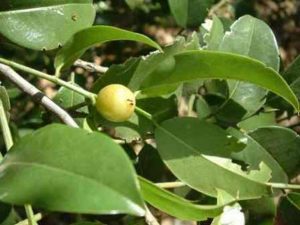
Chaetacme aristata. Photo: Bart Wursten. Flora of Zimbabwe
On our way back to the Land rover we stopped to admire Protea petiolaris with its sickle shaped leaves, their base so narrowed that it appears as though there is a petiole present, which explains the specific name, and Myrica pilulifera, the broad-leaved Waxberry which like so many trees that day was so incredibly variable, in this case the margin of the leaf varied from jaggedly toothed to apparently entire. It was in this area that we saw Vangueria apiculatum (not Canthium lactescens which was our first guess). After lunch there was time for a quick look at vegetation of the stream where we were picnicking, and it was remarkable that we found several species which we had not seen higher up. These included Ilex mitis, the African holly with the characteristic yellow patches on the leaves looking as though it is suffering from a nutritional deficiency. We were also able to compare the shiny leaf Rhamnus prinoides (prinoides meaning like Prinus i.e. Ilex; not prunus) with Charistylis rhamnoides (which means like rhamnus) and see the similarity between their leaves, the main difference being that those of Charistylis are not shiny and they look as though the veins have been pinched into the midrib. Once this character became known there was no mistaking it.
And then it was time to leave the mountain. Thanks to Mrs. Sybil Duncanson for all she did on the bus, counting heads and seeing that all were present and had signed the register and also to all who came and expressed their enjoyment of the day in a most generous way in the form of extra donations towards the cost of the hired Land rover. Ian Milton, our Treasurer, reports that we made a profit of $1.17 on the trip.
Prior to the trip I had stuck a few pressed specimens into Paddington Bear Scrap books and these were passed around, so that on the way out people could anticipate what they hoped to see and on the way home remember and enjoy what they had seen.
-Meg Coates Palgrave – President
ZIMBABWE SCIENCE NEWS VO. 15, NO 6, JUNE 1981
This issue is about Science Education. Indigenous trees of Zimbabwe by Trevor Gordon – species presented Trichocladus ellipticus.
This is an appropriate time for an article on Trichocladus ellipticus, white witch hazel, as the one in the Botanic Garden is presently in flower and the scent can even be appreciated from as far away as Fifth Street as one drives past. On the other hand at close range it is not heady and unpleasant. This tree which comes from Gorongosa Mountain and is in the medium to low altitude Rain Forest section near the Nuxias.
MATABELELAND CALENDAR
Sunday August 2nd : To Matopos National Park; meet at Retreat Shopping Centre 0830 and bring lunch.
Sunday September 13th : Joint field meeting with the O.A.Z to go to Balla Balla Brachystegia area. Meet at Ascot Shopping Centre at 0800 hours or at Hotel Rio at 0815 hours; bring lunch.
-Meg Coates Palgrave – President


